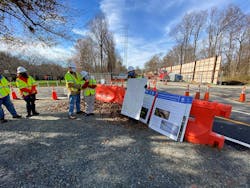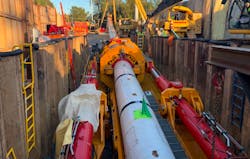A Flexible Approach to Trenchless Construction
In 2018, the Virginia State Corporation Commission approved a 230 kV underground line, which began construction in fall 2020. The 4.3-mile line project located, in part, near a densely populated residential area was necessary due to increased electrical demand in Northern Virginia.
During the planning and engineering process, Dominion Energy selected the open trench method to install the underground cable for most of the route. The open trench method not only provided lower risks compared to other underground methods but gave construction crews the most accessibility to the work area.
Additionally, the open trench method is typically installed three to four feet below grade, much shallower than trenchless methods. However, one section along the route intersects with two interstate highways and a metro rail track. The open trench method would not be feasible for this location. The team determined that horizontal directional drilling (HDD) was the best way to install the new cable under the existing facilities.
“The team chose the HDD method because it is safe and effective, the most common method of construction in these situations, and lower in cost than the alternatives,” said Project Manager John Kascsak.
In spring 2021 — almost one year into the anticipated two-year project — the drilling operation resulted in several inadvertent return (IR) events where drilling fluid migrates to the surface somewhere along the drilling alignment. Certain geologic conditions, such as porous or fissured soil units and discontinuous rock formations (e.g., porous or fractured) can create an environment more susceptible to IRs than more competent formations of the same type of soil. The team documented 11 such instances between December 2020 and May 2021, seven on path one and four on path two.
The team employed enhanced techniques to mitigate against IRs in response to these occurrences. This included surface monitoring using LiDAR and hiring a specialist to monitor the condition of the drilling fluid. However, the team paused drilling activities as mitigation measures were exhausted and ineffective during the drilling of path two. Fortunately, crews completed path one without any major IRs near the end of 2020.
Dominion Energy considered the potential for IRs in the initial planning stages. However, the location and number of IRs in short succession along path two created a potential safety concern for travelers along the interstate. These concerns compelled the team to consider alternative trenchless technologies to complete the project.
The project team partnered with GeoEngineers, an expert in trenchless technology, and chose the Direct Pipe method to finish the second path. Direct Pipe combines techniques from HDD and the micro tunneling method to install underground cables. It is a more streamlined method than HDD, as the pipe is installed as the tunnel develops. Dominion Energy chose Direct Pipe for several reasons:
Due to the reduction of annular pressure, Direct Pipe was determined to be the best method to reduce the risks of IRs.
- Direct Pipe has a relatively small footprint, so additional work areas are not necessary.
- Most of the work can be accomplished from one side of the alignment, so there is less impact on the community.
- It reduces the time required for installation since no reaming processes are needed.
While Direct Pipe was determined to be the best solution to finish this project, it is not always the best solution for utility companies. Direct Pipe has technical limitations and is significantly more expensive than HDD. Additionally, Direct Pipe was developed after HDD, making it a newer and less tested
practice in the industry.
“Both Direct Pipe and HDD are practical and effective methods to install underground infrastructure. However, both have specific technical limitations,” said GeoEngineers Senior Consultant Gary Castleberry. “When evaluating a trenchless installation, careful consideration must be given to available workspace, subsurface conditions, length and diameter of the crossing and depth below the feature or obstruction to be crossed. Often an evaluation of this nature will help the design engineer and project team determine the preferred installation technique.”
In addition to resolving IRs, the project team was committed to being transparent with the community regarding the project delays and thought creatively on ways to keep neighbors engaged and informed. Community outreach has been a critical emphasis since the beginning of the project, mainly due to the proximity of construction work to residential homes.
Dominion Energy hired a community liaison before drilling commenced in 2020 to provide localized support, answer questions, and relay weekly updates to community members and other local stakeholders. These updates were also made available on a new project website with interactive educational tools describing the construction methods. The team also scheduled community tours of the drill locations. This proved most successful as it allowed the public to ask questions to the team and see the magnitude of the operations. These efforts helped the community better understand the project team’s reasoning for changing the construction method.
“The completion of this project requires intense coordination with multiple local and state regulatory permitting agencies, park authorities, numerous HOA’s, county agencies, county supervisors and countless internal and external stakeholders,” said Kascsak. “All of this was, and continues to be, accomplished during one of the worst pandemics in modern history.”
“The heightened level of outreach support for this project helped our team avoid additional permitting delays when we pivoted to the Direct Pipe method. Our goal was to finish path two as quickly as possible. Strengthening community relationships over the past two years allowed us to share our new plan quickly with local permitting agencies and resume work in an adequate timeframe,” said Electric Transmission Communications Specialist Ann Gordon Mickel.
Following approval from the required permitting agencies, the Direct Pipe construction officially began in fall 2021. The team hopes to complete the process by late January 2022, with overall underground line completion by the end of 2022.
Ann Gordon Mickel is a communications specialist for Dominion Energy in Electric Transmission Planning and Communications. She oversees transmission projects from the conceptual phase through construction, allowing her to see the full scope of project execution and providing support to the project team. She is skilled at identifying controversial topics to help project teams navigate potential challenges, including the regulatory and local permitting process, customer demands and conflicts regarding construction. Mickel is a graduate of Elon University with a bachelor of arts degree in strategic communications.
John Kascsak is an electric transmission strategic projects advisor with Dominion Energy. An innovative leader with more than 25 years of experience in project management, operations, maintenance and engineering & design fields, Kascsak is instrumental in the planning, design and construction of transmission and substation projects in Dominion Energy’s service territory to ensure all deliverables are met to scope, schedule and budget. Kascsak is a graduate of Virginia Commonwealth University with a bachelor of science in electrical engineering and is pursuing an MBA in executive leadership from James Madison University.
Gary Castleberry is a senior consultant at GeoEngineers, Inc. He has been involved in the Horizontal Directional Drilling and Pipeline industries for more than 20 years. In his role at GeoEngineers he focuses on preparing feasibility studies and detailed design for HDD, Direct Pipe and other types of trenchless installations. Castleberry is a graduate of Old Dominion University with a bachelor of science in civil engineering technology and of Missouri University of Science and Technology with a master of engineering in Geotechnics.
Charlotte Dean is a senior communications specialist for Dominion Energy in Electric Transmission Planning and Communications.She serves as chief copy editor managing internal and external stakeholder communications. She also supports the development of communications on behalf of the organization that are responsive to distinct audiences. Passionate about volunteering, she serves as board chair of the Chester Family YMCA and is a board member of The Next Move Program. Dean is a graduate of Virginia Commonwealth University.
About the Author
Ann Gordon Mickel
Ann Gordon Mickel is a Communications Specialist for Dominion Energy in Electric Transmission Planning and Communications. In this role, she oversees electric transmission projects from the conceptual phase through construction, allowing her to see the full scope of project execution and providing valuable support to the project team. She is skilled at identifying controversial topics to help project teams navigate potential challenges, including the regulatory and local permitting process, customer demands and conflicts regarding construction. Ann Gordon is a graduate of Elon University with a Bachelor of Arts degree in Strategic Communications.
Gary Castleberry
Gary Castleberry is a Senior Consultant at GeoEngineers, Inc. Gary has been involved in the Horizontal Directional Drilling and Pipeline industries for more than 20 years. In his role at GeoEngineers he focuses on preparing feasibility studies and detailed design for HDD, Direct Pipe and other types of trenchless installations. Gary is a graduate of Old Dominion University with a Bachelor of Science in Civil Engineering Technology and of Missouri University of Science and Technology with a Master of Engineering in Geotechnics.
John Kascsak
John Kascsak is an Electric Transmission Strategic Projects Advisor with Dominion Energy. An innovative leader with more than 25 years of experience in Project Management, Operations, Maintenance and Engineering & Design fields, Kascsak is instrumental in the planning, design and construction of transmission and substation projects in Dominion Energy’s service territory to ensure all deliverables are met to scope, schedule and budget. John is a graduate of Virginia Commonwealth University with a Bachelor of Science in Electrical Engineering and is pursuing an MBA in Executive Leadership from James Madison University.


